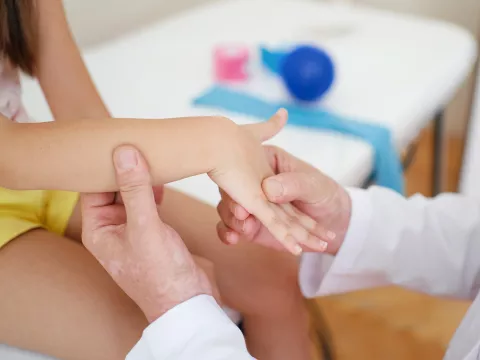- AdventHealth

Choose the health content that’s right for you, and get it delivered right in your inbox.
When you think of arthritis, it’s natural to think of it as a painful disease process that sets in with age. In reality, 1 in 1,000 kids in the United States has a juvenile arthritis diagnosis. We’re here to spread awareness about juvenile idiopathic arthritis so parents and caregivers know the signs and how to get the best treatment for their child.
What is Juvenile Idiopathic Arthritis (JIA)?
JIA is the term used to describe arthritis that affects children. If you suspect it in your child, it’s very important to get it diagnosed and start treatment early. If it goes untreated for too long, JIA can cause serious side effects such as stunted growth, blindness, joint deformities and other irreversible conditions.
Signs and Symptoms of JIA
Because many of the symptoms of JIA mimic other conditions, it’s considered a “diagnosis of exclusion.” That means all the other possibilities must be ruled out first before the JIA diagnosis can be made.
If you notice any of the following signs and symptoms in your child, be sure to bring them in to see their pediatrician or primary care physician:
- Warm, red, swollen, tender joints
- Stiffness in the morning
- Slowed activity level and mobility
- Joint, knee, ankle or leg pain
- Loss of appetite and weight loss
- Blurry vision with dry, red eyes
- Fatigue
- Fever
- Rash
Your pediatrician or family doctor may refer your child to a pediatric rheumatologist to further investigate the possibility of JIA.
It’s also important to note that JIA symptoms come and go. There may be times of increased inflammation and worsening symptoms. These “flares” can last for a few days up to months.
Caring for Your Child After Their JIA Diagnosis
Here are some helpful tips to help your child and your whole family cope after their JIA diagnosis:
Educate yourself: Seek information about the disease process and treatment plan.
Be flexible: Take one day at a time and focus on what’s most important on a given day. Adjust your child’s and family’s plans to accommodate flares so every challenge along the journey can be a more positive experience.
Be part of the health care team: Encourage your child to take an active role in their own health care by being an active partner yourself.
Be open and honest: Talk openly together about your feelings. Provide age-appropriate education to your child regarding their disease process and the treatment plan without hiding things from them. If a procedure is going to be uncomfortable or scary, be honest about it in a way they can understand.
Educate yourself: Seek information about the disease process and treatment plan.
Help your child keep their identity: Make sure your child remains involved with their peer group and activities. If your child has trouble fully participating in sports or dance and that has been important to them, find a way to keep the connection.
Offer options: Allow your child to make as many choices regarding their treatment plan as possible, within reason.
Spend quality time together: The Child Illness and Resilience Program urges families to keep routines intact to provide a sense of stability during difficult times. And celebrate milestones together, like a month with no missed school days, or a sibling’s role in the school play.
Unite as a team: Parents — both those living together and those who are separated or divorced — should be aligned when it comes to a treatment plan.
Limitations Caused by JIA
Children with JIA tend to have trouble sitting for long periods due to discomfort and achiness. Long road trips and having to sit all day in school can be a challenge for them, and cause frustration along with the physical aches and pains.
Encourage your little one to do some leg and hip stretches beforehand when they know they’ll need to be still for a while. Regular stretching is a wonderful way to increase flexibility and relaxation, and decrease pain and stiffness.
The good news is that children with JIA are typically unrestricted from playing sports, as long as they follow the same safety rules that every child must. The availability of treatments and medications makes it very possible for them to run, play and do well athletically.
During a flare, children are encouraged to self-limit their activities without stopping completely. They can talk to their coach about an alternate workout to keep the flares from getting worse.
The bottom line is that with early diagnosis and treatment with the right interventions and support, your child can live a relatively normal life with JIA.
Treatment Options for JIA
According to the Arthritis Foundation, early aggressive treatment is key to getting JIA under control. There are different treatments depending on JIA type and severity. Typical medication includes many over-the-counter options like Ibuprofen or Aleve to reduce pain and swelling.
Other treatment options include physical and nondrug therapies like isometric exercises designed to stretch and strengthen the muscles, and healthy lifestyle habits such as eating a well-balanced, nutrient-rich diet.
Since two-thirds of children diagnosed with JIA end up with rheumatoid arthritis in adulthood, it’s important that they see their doctors regularly for check-ups, and to check in with them during flares. Management of arthritis is very important to avoid complications and disabilities associated with the disease.
Exceptional Pediatric Rheumatology Care
We're here to help with individualized treatment plans and family-centered care. Our experts are here to support and guide your family as we navigate your child’s treatment journey together.
Learn more about our services here. We want to help your kids be happy, healthy and whole for life.




